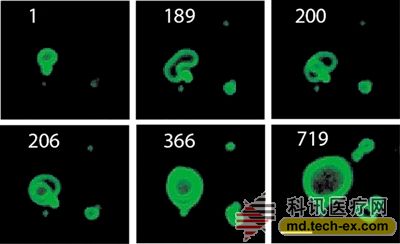Release date: 2015-06-25

Above picture Time-lapse shot of the growing cell membrane, the number of membranes growing increases with time.
Researchers at the University of California, San Diego, have successfully synthesized an artificial cell membrane that grows like living cells. This achievement allows scientists to more accurately reproduce the properties of living cell membranes in future research, and will become an important tool for the study of synthetic biology and origin of life. Related papers were published in the Proceedings of the National Academy of Sciences published this week.
The cell membrane is a membrane of a double phospholipid layer, which is a dynamic structure that can grow in all living organisms. So far, scientists have created a large number of structures that mimic phospholipid membranes, but there is an essential difference from natural membranes: these biomimetic systems cannot sustain growth because they cannot supplement phospholipid-synthesis catalysts.
“Other scientists have taken advantage of the ability of lipids to automatically form double-layered vesicles, which are much like cell membranes, but so far no one has been able to imitate natural cell membranes, allowing their phospholipid membranes to continue to grow.†Research team leader, Neil Devalaj, an associate professor of chemistry and biochemistry, explains, “Our artificial cell membranes can continue to synthesize all the essential components and form more catalytic membranes. Although they are completely artificial, they can mimic those complex activities. Many characteristics of living things, such as the ability to respond to environmental information and adapt to the environment."
The team replaced a natural complex biochemical pathway network with a single, automated catalyst that also drives membrane growth. This system can continuously transform the simpler and higher energy "basic building materials" into new artificial membranes, which can not only continuously synthesize phospholipids, grow into vesicles, but also preferentially combine with certain special substances to change their physical components. To adapt to environmental changes.
“Our results show that when a simpler chemical basic building material is supplied, a complex lipid membrane with infinite self-synthesis capability can emerge.†Dewaraj said, “The synthetic cell membrane can grow like a real cell membrane, right. Synthetic biology and the study of the origin of life will be an important new tool."
Editor-in-chief
In the past few years, scientists have used a pot of "small molecule chowder soup" to extract the biomimetic cell membrane. Now the same kind of membrane has been proven to grow, which implies that the boundary between the inorganic world and the organic world is minimal. The complexity of organic matter is just energy perfusion. the result of. The bio-big man Venter once created "artificial cells," but it was assembled with semi-finished products. Is it possible to naturally "sprout" life from the original environment simulated in the laboratory? See what the scientists do next.
Source: China Science and Technology Network - Technology Daily
Scalpel Blades,Surgical Blade,Safety Scalpel,Surgery Blade
Surgimed Medical Supplies Co.,Ltd , https://www.surgimedcn.com